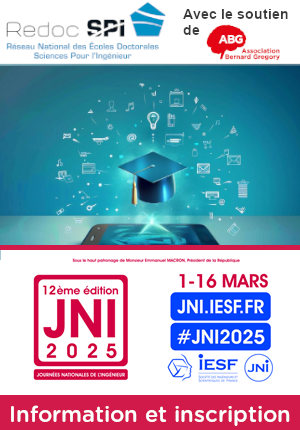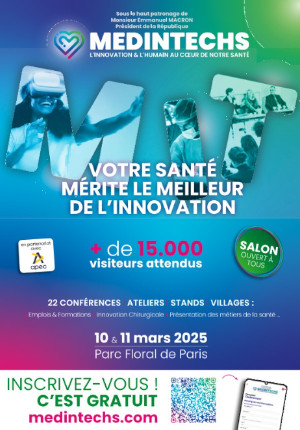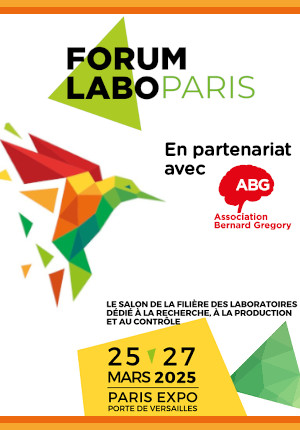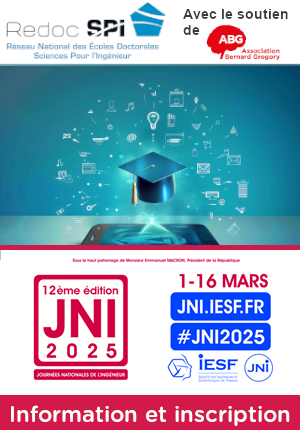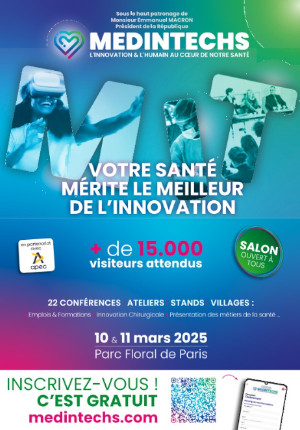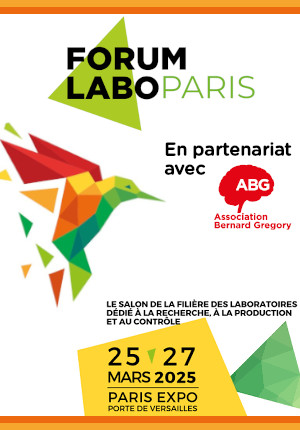Précipitation photo-induite de nanocristaux dans une nouvelle génération de fibres optiques dédiés aux environnements à haute température // Fs-Laser Induced precipitation of nanocrystals in next generation of optical fibers dedicated to High Temperature
|
ABG-128549
ADUM-61059 |
Sujet de Thèse | |
| 13/02/2025 |
Université Paris-Saclay GS Chimie
Orsay cedex - France
Précipitation photo-induite de nanocristaux dans une nouvelle génération de fibres optiques dédiés aux environnements à haute température // Fs-Laser Induced precipitation of nanocrystals in next generation of optical fibers dedicated to High Temperature
- Physique
Laser femtoseconde, science des matériaux, fibres optiques, capteurs, cristallisation, verres aluminosilicatés
Femtosecond laser, materials science, optical fibers, optical sensors, crystaliization, aluminosilicate glasses
Femtosecond laser, materials science, optical fibers, optical sensors, crystaliization, aluminosilicate glasses
Description du sujet
voir ci-dessous en anglais
------------------------------------------------------------------------------------------------------------------------------------------------------------------------
------------------------------------------------------------------------------------------------------------------------------------------------------------------------
High temperatures (typically above 800°C) are common in a wide range of technological fields, such as turbine engines in trains, aircraft, and space vehicles, as well as in manufacturing processes (e.g., 3D laser additive manufacturing of metal or ceramic parts, the steel and glass industries), nuclear reactors (for future reactor instrumentation and tokamaks), photonics (for continuous wave (CW) kW- level fiber lasers), structural health monitoring, and fire alarm systems. As a result, there is a growing need for functionalized oxide glass-based photonic devices that can withstand such high-temperature (HT) environments, offering significant advantages over conventional thermocouples, such as compactness, high sensitivity, and resistance to corrosive conditions. To develop glass-based HT photonic devices (e.g., Bragg gratings or waveguides), the glass must be functionalized, which typically involves stable refractive index modulation. Femtosecond laser direct writing (FLDW) is the most suitable tool for this purpose, as it enables nonlinear light absorption, generating extreme field intensities
(10-100s TW/cm²) along with high pressures and temperatures (hundreds of GPa and thousands of °C) in a confined volume of just tens of µm³. These conditions induce unique, oriented material transformations in 3D, driven by thermal, mechanical, and optical forces, such as chemical species migration, oxide dissociation, and nanocrystallization.
Currently, porous nanostructures in silica or Ge-doped silicate glasses (Types II and III) demonstrate the best performance but lose stability as they fully erasure around 1265°C for 30 minutes or 1050°C for one month in pure silica. A paradigm shift is therefore required to achieve stable operation in the 1000–1500°C range. In 2024, our consortium demonstrated that fs-laser-induced nanocrystallization (3:2 Mullite, t-ZrO₂) in Al₂O₃-SiO₂ and ZrO₂-Al₂O₃-SiO₂ bulk glasses resulted in a positive index contrast (Δn ~10⁻³) that remained thermally stable up to 1600°C for 30 minutes. This world-record thermal stability for fs-laser-induced structures in glass is the result of a newly discovered regime, Type Ic (where 'c' stands for crystallization), where permanent chemical migration and crystallization make this possible. Building on this proof-of-concept, the current PhD project aims to further explore and master this new regime.
------------------------------------------------------------------------------------------------------------------------------------------------------------------------
------------------------------------------------------------------------------------------------------------------------------------------------------------------------
Début de la thèse : 01/10/2025
------------------------------------------------------------------------------------------------------------------------------------------------------------------------
------------------------------------------------------------------------------------------------------------------------------------------------------------------------
High temperatures (typically above 800°C) are common in a wide range of technological fields, such as turbine engines in trains, aircraft, and space vehicles, as well as in manufacturing processes (e.g., 3D laser additive manufacturing of metal or ceramic parts, the steel and glass industries), nuclear reactors (for future reactor instrumentation and tokamaks), photonics (for continuous wave (CW) kW- level fiber lasers), structural health monitoring, and fire alarm systems. As a result, there is a growing need for functionalized oxide glass-based photonic devices that can withstand such high-temperature (HT) environments, offering significant advantages over conventional thermocouples, such as compactness, high sensitivity, and resistance to corrosive conditions. To develop glass-based HT photonic devices (e.g., Bragg gratings or waveguides), the glass must be functionalized, which typically involves stable refractive index modulation. Femtosecond laser direct writing (FLDW) is the most suitable tool for this purpose, as it enables nonlinear light absorption, generating extreme field intensities
(10-100s TW/cm²) along with high pressures and temperatures (hundreds of GPa and thousands of °C) in a confined volume of just tens of µm³. These conditions induce unique, oriented material transformations in 3D, driven by thermal, mechanical, and optical forces, such as chemical species migration, oxide dissociation, and nanocrystallization.
Currently, porous nanostructures in silica or Ge-doped silicate glasses (Types II and III) demonstrate the best performance but lose stability as they fully erasure around 1265°C for 30 minutes or 1050°C for one month in pure silica. A paradigm shift is therefore required to achieve stable operation in the 1000–1500°C range. In 2024, our consortium demonstrated that fs-laser-induced nanocrystallization (3:2 Mullite, t-ZrO₂) in Al₂O₃-SiO₂ and ZrO₂-Al₂O₃-SiO₂ bulk glasses resulted in a positive index contrast (Δn ~10⁻³) that remained thermally stable up to 1600°C for 30 minutes. This world-record thermal stability for fs-laser-induced structures in glass is the result of a newly discovered regime, Type Ic (where 'c' stands for crystallization), where permanent chemical migration and crystallization make this possible. Building on this proof-of-concept, the current PhD project aims to further explore and master this new regime.
------------------------------------------------------------------------------------------------------------------------------------------------------------------------
------------------------------------------------------------------------------------------------------------------------------------------------------------------------
Début de la thèse : 01/10/2025
Nature du financement
Précisions sur le financement
Contrats ED : Programme blanc GS-Chimie
Présentation établissement et labo d'accueil
Université Paris-Saclay GS Chimie
Etablissement délivrant le doctorat
Université Paris-Saclay GS Chimie
Ecole doctorale
571 Sciences Chimiques : Molécules, Matériaux, Instrumentation et Biosystèmes
Profil du candidat
Le candidat doit avoir un profil « Optique et science des matériaux » avec des connaissances en chimie physique, et idéalement dans les matériaux vitreux. Il doit être capable de gérer un laser de haute technologie et comprendre les paramètres optiques. Caractériser les changements structuraux du verre photoinduit à l'échelle nanométrique, nous utilisons une série de méthodes spectroscopiques (Raman, l'absorption ou la luminescence, la diffraction des rayons X etc ...) et de microscopie électronique (MEB, MET, EBSD…) Pour les interprétations, nous avons besoin de concepts en physique du solide et en mécanique du milieu continu. La connaissance de l'anglais est bien sûr également un prérequis.
The applicant must have a background in 'Optics and Materials Science' with knowledge in Physical Chemistry, and ideally in glass science. He must be able to handle a high-tech laser and understand the optical settings. To characterize the structural changes photoinduced glass at the nanometer scale, we use a series of spectroscopic methods (Raman, absorption or luminescence, X-ray diffraction etc ...) and electron microscopies (SEM, TEM, EBSD…) For interpretations, we need concepts in solid state physics and mechanics of continuous medium. Knowledge of the English language is mandatory.
The applicant must have a background in 'Optics and Materials Science' with knowledge in Physical Chemistry, and ideally in glass science. He must be able to handle a high-tech laser and understand the optical settings. To characterize the structural changes photoinduced glass at the nanometer scale, we use a series of spectroscopic methods (Raman, absorption or luminescence, X-ray diffraction etc ...) and electron microscopies (SEM, TEM, EBSD…) For interpretations, we need concepts in solid state physics and mechanics of continuous medium. Knowledge of the English language is mandatory.
01/04/2025
Postuler
Fermer
Vous avez déjà un compte ?
Nouvel utilisateur ?
Besoin d'informations sur l'ABG ?
Vous souhaitez recevoir nos infolettres ?
Découvrez nos adhérents
 CASDEN
CASDEN  MabDesign
MabDesign  Institut Sup'biotech de Paris
Institut Sup'biotech de Paris  ADEME
ADEME  ANRT
ANRT  ONERA - The French Aerospace Lab
ONERA - The French Aerospace Lab  Institut de Radioprotection et de Sureté Nucléaire - IRSN - Siège
Institut de Radioprotection et de Sureté Nucléaire - IRSN - Siège  Ifremer
Ifremer  Généthon
Généthon  SUEZ
SUEZ  Tecknowmetrix
Tecknowmetrix  Aérocentre, Pôle d'excellence régional
Aérocentre, Pôle d'excellence régional  MabDesign
MabDesign  CESI
CESI  TotalEnergies
TotalEnergies  Laboratoire National de Métrologie et d'Essais - LNE
Laboratoire National de Métrologie et d'Essais - LNE  PhDOOC
PhDOOC  Nokia Bell Labs France
Nokia Bell Labs France  Groupe AFNOR - Association française de normalisation
Groupe AFNOR - Association française de normalisation



